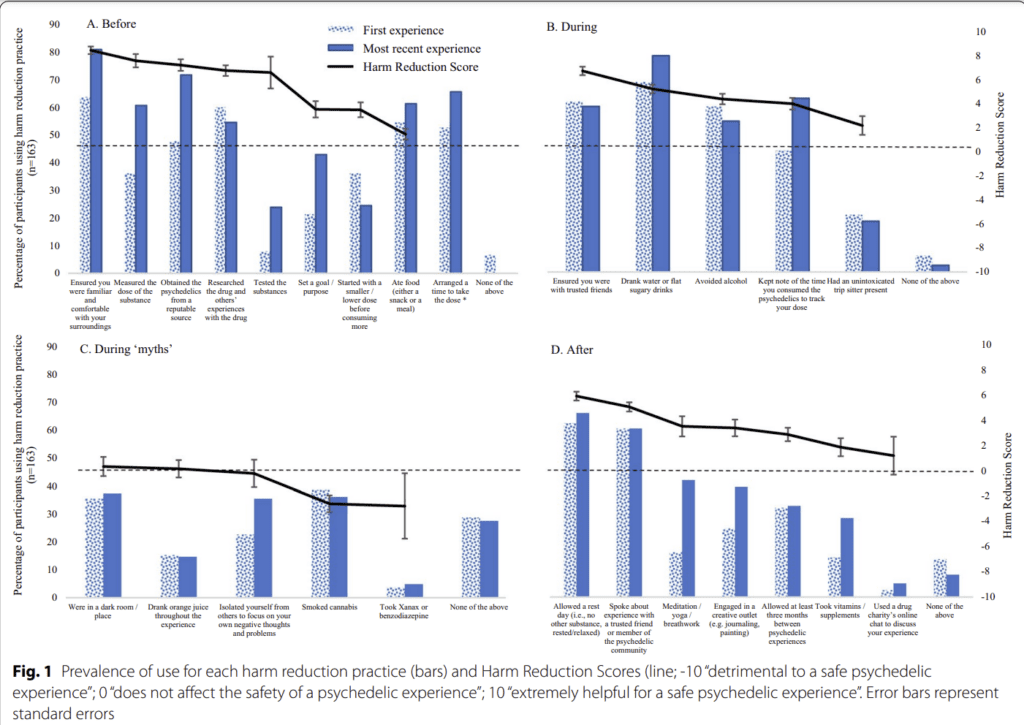In recent years, the revival of psychedelic research has brought new insights into both clinical and recreational use of substances like LSD, psilocybin, and DMT. While clinical settings ensure controlled environments for therapeutic benefits, recreational use lacks such regulation, raising concerns about safety and the quality of psychedelic experiences. Today I want to focus on one study that clearly shows the positive impact of harm reduction approaches on the course of the trip and the psychedelic experience itself.
Study Overview

The paper Are you tripping comfortably? Investigating the relationship between harm reduction and the psychedelic experience by Madelene Palmer and Olivia M. Maynard explores the practices and perceptions of harm reduction among recreational psychedelic users.
The study employed a mixed methods approach, utilizing an online survey to gather both quantitative and qualitative data from 163 participants. Participants were asked about their first and most recent psychedelic experiences, focusing on the harm reduction practices they employed. Qualitative data were collected through open-ended questions.
ANOVA stands for Analysis of Variance, a statistical method used to compare means among three or more groups to determine if there are any statistically significant differences between them. In the context of the study ANOVA was used to analyze the data and assess the differences in harm reduction practices and their effects on psychedelic experiences.
In the study, ANOVA was used to:
- Compare Harm Reduction Scores: Determine whether there were significant differences in the use of harm reduction practices between the first and most recent psychedelic experiences.
- Examine Relationships: Assess the association between harm reduction practices and outcomes such as emotional breakthrough (EBI scores) and challenging experiences (CEQ scores).
The study found a significant main effect of occasion (F (1,162) = 28.32, p < 0.001), indicating that harm reduction practices were more frequently used in participants’ most recent experiences compared to their first. Additionally, the interaction between time and occasion was significant, suggesting that specific harm reduction practices varied across different stages (before, during, and after the psychedelic experience).
By using ANOVA, the researchers could robustly test their hypotheses and draw meaningful conclusions about the evolution and impact of harm reduction practices among psychedelic users.
Key Findings: Importance of Harm Reduction

Analysis revealed a significant increase in harm reduction practices from participants’ first to their most recent experiences. Notably, these practices correlated with more positive experiences and fewer adverse effects, particularly during initial use. Common practices include:
- Ensuring familiarity and comfort with surroundings.
- Measuring and testing the dose of the substance.
- Obtaining psychedelics from reputable sources.
- Engaging in mindfulness practices like meditation.
Experience-Based Insights
Qualitative responses highlighted profound, often life-changing benefits from psychedelic experiences when proper harm reduction strategies were employed. Many users emphasized the critical nature of “set and setting” — a well-prepared mental state and a safe, comfortable environment. Experienced users reported evolving their approaches over time, indicating a learning curve that enhanced safety and overall experience quality.
Quantitative Findings: Using ANOVA, the study found that harm reduction practices were positively associated with EBI scores and negatively associated with CEQ scores, particularly during the first psychedelic experience. This suggests that effective harm reduction can enhance positive outcomes and reduce negative experiences.
Qualitative Insights:
- Profound Positive Experiences: Participants often described transformative and life-enhancing experiences facilitated by psychedelics.
- Importance of the Drug: The type and source of the psychedelic substance significantly influenced the perceived necessity and effectiveness of harm reduction practices.
- Set and Setting: The psychological mindset (set) and physical environment (setting) were critical in shaping the psychedelic experience. Participants emphasized creating a safe, calm space and preparing mentally and emotionally for the trip.
Strengths and Limitations
The study provides a detailed characterization of harm reduction practices among psychedelic users. The mixed methods approach offers both quantitative and qualitative insights.
The sample may not be representative of all psychedelic users, as participants were recruited from specific forums and communities. Self-reported data may be subject to recall bias, particularly for the first psychedelic experience.
Conclusions and Future Directions

The study suggests a gap in harm reduction application among novice users, likely due to unawareness or unplanned, spontaneous use scenarios. This highlights the need for targeted educational efforts that inform new users about effective harm reduction techniques to ensure safer and more positive experiences.
The article underscores the importance of harm reduction practices in enhancing the safety and positive outcomes of psychedelic experiences. By increasing awareness and providing tailored advice, it is possible to reduce risks and maximize the therapeutic and transformative potential of psychedelics.
Future research should focus on refining harm reduction practices and exploring their effectiveness across different user demographics and settings. Additionally, understanding the role of challenging experiences and their potential for positive transformation is essential.




